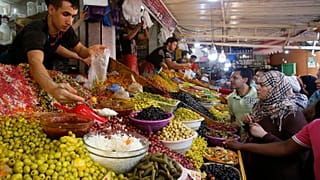Morocco
It’s a dress tradition dating back to the 12th century. Now, a collection of Moroccan caftans is on show at the National Finery Museum in the capital, Rabat, showcasing opulent heritage pieces alongside cutting edge modern tunics.
'Yesterday's Caftan Seen Today' includes some dating from the 19th and 20th centuries, reflecting traditions in the use of fabrics and elaborate embroidery.
One piece, known as the Caftan of Oujda, is made of rich burgundy-coloured velvet, embroidered with gold threads.
It dates back to the 19th century, from the city of Oujda, and is crafted with delicate embroidery known as "Quitan", a traditional style popular in the eastern region.
"The choice was to exhibit rare pieces that represent both Moroccan roots and contemporary influences of designer Fadila El Gadi, but which respect the deep-rooted heritage of Moroccan couture," said curator, Fatima Zahra Khlifi.
At her workshop in the nearby city of Salé, traditional fashion designer Mounia Tounssi discusses the details of a new caftan with a worker.
One of the first steps is embroidering the fabric for these high quality garments which are made here for special occasions and events.
One person hand sews the sfifa, or braid, one of the most prominent decorative elements of the Moroccan caftan, onto the material. Another manually attaches shiny stones to the fabric, as part of the decorative process.
Tounssi says the local caftan will never disappear and demand for it will never decrease.
“It remains the most important garment for all ceremonies and celebrations. We also see that many young people are interested in learning the techniques and are eager to contribute to the caftan’s evolution," she said.
The Moroccan caftan is currently being considered for inscription on UNESCO’s list of Intangible Cultural Heritage.
Its application highlights the fact that various designs and styles were developed in each region of the country and that their creation involved many different craftspeople.
At the National Finery Museum in Rabat, visitors can see 15 pieces belonging to the museum in addition to 30 pieces by designer El Gadi.
She’s known for her use of innovative materials, shapes, and colours.
The exhibition runs until the end of September.











02:20
Seychelles marks 40 years of Kreol festival with vibrant tribute to identity and heritage
Go to video
Documentary reveals underground world of South Korean tattoo artists
02:22
Graffiti transforms Conakry’s walls into canvases for change
02:20
Met museum unveils ‘Divine Egypt’ exhibition on ancient gods
01:00
Expo 2025 Osaka closes after six months and 28 million visitors
02:20
New exhibition celebrates Yves Saint Laurent’s love of dogs